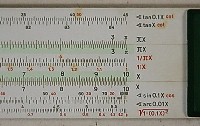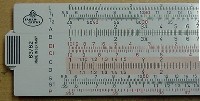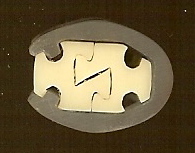|
|

Sellers' Corner
Walter Shawlee 2, Kelowna, BC, Canada
The Slide Rule Universe
The Strange Phenomenon of Faber Scale Bleeding
Most people that have owned a few plastic Faber Castell rules have come across one with "bleeding scales" at one time or another. The white bodies of the rules appear to have anywhere from a yellow to a red-brown stain spreading out from the scales (most commonly black, but also red) like some kind of strange watercolor paint blotch. It can also make the scales themselves look green or orange, and very fuzzy. It can’t be removed by any surface cleaning method, and often appears to get worse over the ownership of the rule. No other rule family shows this strange characteristic, and many makers from Hemmi to Aristo have virtually identical body styles and materials with filled scales, yet this effect is not present on their rules.
Exactly what chemistry is at work here is unclear, but it is clear that a solvent or pigment used in the ink to fill the scales, or possibly a mold-release or cleaning agent, diffuses into the white PVC body material. The A and D scales on some rules often seem to be the only ones bleeding, so possibly it is caused by some lubrication used to improve the slide action. The effect is deeper than just the surface, and has proven very stubborn to remove. Over the last 5 years, I have tried all kinds of experiments on these rules, and I can now usually recover the rule to about 95-100% of its original condition with some patient work. Rules with black scale bleeding are the easiest to recover, red scales are the hardest to fix.
See Fig. 1 for an example with random red bleeding around the legends and numbers (see cot and 50 in particular).
Sunlight combines heat (long-wave IR) and very strong short-wave UV, and this combination is what drives off and bleaches out the offending pigments. I have tried heat and UV individually, but there is no real improvement, even over long periods. Only the huge energy of direct sunlight is powerful enough to penetrate the PVC and eliminate the bleeding. In fact, only SUMMER sunlight (at my latitude in Canada) is strong enough to work. I also found that even once it appeared removed, it was useful to wait a few days, and if any faint traces re-appear, to re-bleach for the best overall effect. Clearly some subsurface material continues to migrate to the surface after the first session. It is not uncommon to see it re-appear after 6 months in storage.
See Fig. 2 for a badly bleeding example fully cleaned after 2 sun-baking sessions.
Several recent acquisitions also helped answer a question that has really bothered me for some time. It seemed to me that leather cased rules developed this problem more often than plastic cased ones, and leather cased rules seemed to return to the undesirable bleeding state over long periods of time. I recently got several rules with terrible scale bleeding, but which had reversed slider scales protected by the closed back body. In these examples, the front scales were in terrible condition, but the protected inner scales (not in contact with the leather case) were perfect.
My conclusion has been that some gaseous transfer occurs between the leather cases and rule surfaces in close proximity over time, and this aids and enhances the spread of the unwanted pigment into the PVC body material. A very similar effect is seen on small SINCO (Scientific Instruments Co.) pocket rules, where the unstable brown dye used in the unfinished leather cases penetrates the top celluloid layer on the bamboo rules, turning them a very unpleasant brown color. Note that most other leather cased rules (K+E, Pickett, Post) have an inner case liner, which prevents the considerable water vapor out gassing from the leather and dye from harming the rule inside. It is worth noting that the FC cases are completely unlined on the most problematic rules.
I believe that some similar process occurs when the display cased rules are exposed to sunlight, the outer clear case yellows, and the scales on the adjacent side become discolored. Here, sunlight seems to play a bad role, in causing out gassing from the case lid, which affects the rule surface underneath, which is unfortunately protected from UV by the case itself. Opaque cased rules (generally the cheaper 52 and 152 series) also seem to have issues when stored in a warm location or sunlight.
Most puzzling is that the same exact rule made in the same timer period can appear in both versions that are badly bleeding and others that look prefect. This really reinforces the idea that some very specific chemistry was used intermittently at FC in either pigments, processing or body materials that triggers this effect.
See Fig. 3 for an example showing where the center A/D body scales turned yellow-green on each side of the slide.
It is not a requirement to be cased for the bleeding effect to appear, but it does seem that the case can make the appearance worse or re-appear, especially in the presence of heat or moisture.
I have had the chance to track these effects over quite a few years, and see the results of rules bleached and then re-stored in original cases, so I have fairly high confidence that these things are true (although one can of course be certain, but wrong):
- Scale bleeding can be largely removed by sun bleaching, and in most cases corrected to almost new condition. A repeated effort a few days later gives the best long-term results.
- Leather cases (especially unlined ones) need a plastic liner to protect the rule from future scale bleeding. A simple thick walled vinyl bag seems to work.
- Display cased rules or opaque plastic cased rules should not be stored in direct sunlight, if they have to be in this position, open the lid or case.
The examples shown were all badly disfigured by scale bleeding, some so badly the scales were almost unreadable in sections (one large blotch). These have all been bleached repeatedly (over about a week) and now look to be in excellent condition. Note the very wide range of production styles and manufacturing dates involved, yet all were restored by the same technique. The pocket rules all had unlined leather cases.
I will keep working on this problem, as it clearly is getting worse as the rules continue to age, but I hope this information can help you control the rules in your own collection.
Walter
walter2 “at” sphere.bc.ca
The Slide Rule Universe
|


Fig. 1 - Red Bleeding

Fig. 2 - Cleaned Example

Fig. 3 - Yellow/Green
|
SlideLites
Dick Rose, Columbus, Ohio
Vintage Instruments
Finding Slide Rules in the Wild
Sandy and I were in Florida recently and stopped into an antique shop or two. Ok…maybe more than two. I always look for slide rules, but don’t expect to find them as I once did. eBay seems to have stripped the antique world of slide rules.
I did find three – nothing too exciting -- priced at about what I sell similar rules for. But I wasn’t disappointed. I don’t look through antique shops just for slide rules. I have lots of other vices, most of which require more space than do slide rules.
But I still have memories of good antique shop/show slide rule finds – a nice Thacher (long ago sold), a column cursored K+E rule (still have that one), a K+E 4031 with a magnifier and magnifier case (sold again), a batch of early Pickett rules (paid too much for those, but what did I know then?), my first 20 inch K+E (I don’t remember the model, but it was only $35. I was so excited then, but now I have many 20 inch rules, so the excitement has diminished), and all the K+E 4081-3’s and Post Versalogs (back then I thought they were pretty rare).
I get notes from many of my Oughtred friends about good slide rule finds still being made and thought it might be interesting if we had a Slide Rule Find section in the Bulletin in which we could report our great new finds. What do you think?
Maybe we could start it out with an article on Great Slide Rule Finds. I’d be glad to write the article as my next column. So if you would like to have some of your great finds included in the article, please send me an email describing your great finds and the circumstances under which you found them. And if you want to brag about the great bargain you got, please include the price you paid (not required).
One more slide rule find…well sort of. About nine years ago, I had a first date with a young lady in Columbus, Ohio. I was living in Kalamazoo, Michigan then. Our first weekend together was spent at many antique shops in the Columbus area, with the young lady in tow. I was looking for slide rules then, but can’t now recall if I found any.
However, a month later I do remember asking Sandy to marry me, and a month after that she said yes. Those of you who know me well know how things turned out. We will celebrate our ninth anniversary next April. Sandy has been my best find of all, far better than any old slide rule.
Dick Rose,
Vintage Instruments
|

|
A Little Known Pickett Slide Rule
Marion Moon, Orange, California
Most of my slide rule collection focuses on end-of-era high-end rules in use around 1970. Some time ago, however, I bought, at auction, a Pickett N-1010 SL-T "Super Power Trig". At first, I didn't pay too much attention to this thinking it was another polyphase or Rietz-type rule. But, after some closer investigation, I discovered a very efficient and flexible rule. This particular version of the 1010 series was, I think, the last one produced and because it was late in the era, not widely available in the current market. As a result, it appears not to be widely known.
This rule is a full duplex non-log-log rule with twenty scales.
The front has: R1, R2, A [B, ST, T, S, C] D, DI, K where the R1 and R2 scales are marked with radical signs (v).
The back has: L, DF [CF, CIF, CI, C] D, DI, Ln.
The rule is about 310 mm long and 39 mm wide. It has a single-hairline magnifying cursor on both sides. There are, as a result, no scale extensions.
This rule is unusual for its size in that it has dual base L (base 10) and Ln (base e) scales. Also, It has a DI scale on both sides of the rule.
This rule has rather minimal gauge marks with p, e and R identified on the DF, CF, CIF, D, D, and DI front scales with unidentified marks at 7854 or p/4. The back has marks at A(p), B(p), C(p), C(R), C(p/4), D(p), D(R), D(p), D(p/4), DI(p), DI(R) where R indicates degrees per radian. The ST scale has gauge marks identified as 1°, ', and " where these represent radians per degree (0.01745), arc-seconds per radian (206265) and arc-minutes per radian (3438) on the C scale.
These marks continue the traditional inconsistent marking on the trig-scales when in fact they have nothing to do with the trig-scales. Having radians per arc-minutes and are-seconds would have been a better choice and offer quicker sine and tangent calculation for very small angles which I believe is Pickett's standard.
The ST scale also uses pure radian scaling which I believe too is Pickett's standard. The trig scales are decimally divided so, this rule would be less useful for those needing degree, minute, second scale marks.
This rule has the advantage of both square and square root scales where many rule including flag-ship rules have only one or the other. The availability of the folded scales DF, CF, and CIF facilitate many computations including off-scale operations. These folded scales also make Lee Johnson's "central drift method" accessible for the student wanting to learn his techniques. The duplication of the DI scale on the trig side of the rule optimizes the computation of complex numbers for those needing such ability. The availability of a number of function scales extends the slide rule's usefulness in dealing with more advanced proportion calculations.
This rule is a very good candidate for one who does a lot of ordinary computation -- that is, no exponential or power function work. The lack of these scales can be compensated by using either of the log scales. Exponential work can be done using the natural log scale Ln. This will take a bit more work the details of which can be found in Hartung's manual "How to use Dual Base Exponential Ln-L Scales" published by Pickett as Form M-21. The availability of the DI scale on the back of the rule aids in the computation of logs of fractional numbers using the traditional methods because the log scales are on the body.
If there are any short falls I would like to see a DIF scale -- there is enough room at the top of the back. This scale is not often suggested but I have seen times when it would have been useful. A Pythagorean or P-scale might at time be useful but American slide rule makers never seemed to consider this scale.
If you are looking for a rule with an unusual scale arrangement or want a rule which allows you to advance beyond an elementary one, this might be a good choice.
|

|
A Strange Little Rule
Clay Castleberry, Oroville, California
It’s small enough to be a pocket rule and even small enough to get lost in your pocket, but I don’t know its history or maker. Through this little article, perhaps someone can tell me the maker and history.
William Oughtred, creator of the first slide rule, made his first linear slide rule by placing two sticks with logarithmic scales together, to simplify the addition and subtraction of the log distances. Later rules had 3 members with a slider being the middle scale member. Only a few rules around today have the Oughtred original design. The Hemmi 22, Student Rule is one of the more common, along with some pencil rules.
This rule has a unique construction, being formed by a plastic extrusion machine that makes both members from the same extrusion, with the scale layouts embossed on later. Someone determined a seemingly, simple, and efficient way of manufacturing both members of the 2-member rule.
It measures only 4.7 inches with a scant 3.9” scale, It does show a “Pat.Pend.” indicating that the maker had hopes The rule has both the A &B, and the C & D scales and is protected by a thin real-leather case. The cursor alignment with the scales, make it a duplex, but with questioned accuracy.
Since the rule does not have a make or model number or a manufacturer, I ask anyone to contact me if you have information on my “STRANGE LITTLE RULE”.
|


Fig. 1 - Special 2-Stick Slide Rule.

Fig. 2 - Side View.
|
|
| |
|
|